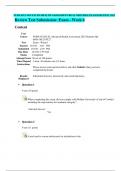Exam (elaborations)
Test Bank For Kelly Vana's Nursing Leadership and Management: Includes Website 4th Edition by R.N. Vana, Patricia Kelly||ISBN 978-1119596615||Latest Update||Complete Guide A+
Test Bank For Kelly Vana's Nursing Leadership and Management: Includes Website 4th Edition by R.N. Vana, Patricia Kelly||ISBN 978-1119596615||Latest Update||Complete Guide A+
[Show more]












